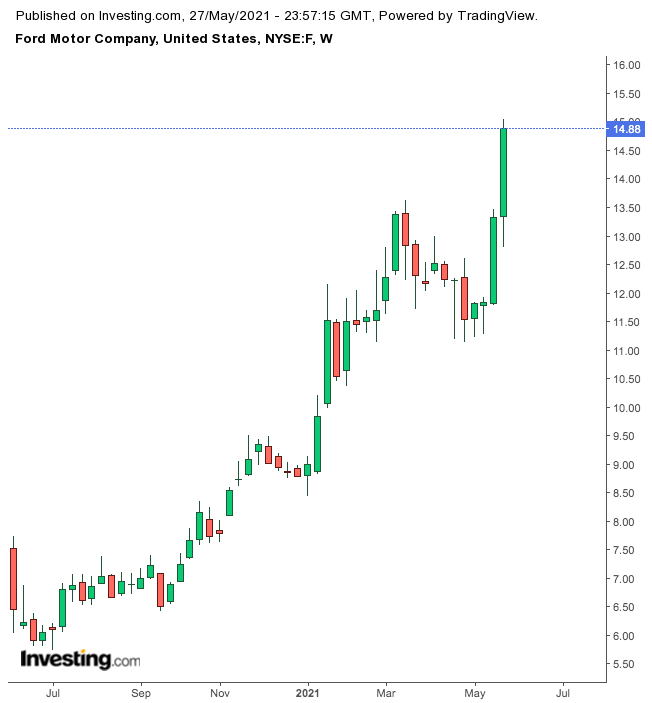Ford (NYSE:F) is finally winning the backing of Wall Street for its turnaround plan after many years of missteps and failures. What’s different this time is the company’s clear messaging on its ambitions in the electric-vehicle market, crafted by its new CEO Jim Farley.
Ford executives told investors on Wednesday that they expect 40% of Ford’s global sales to be fully electric by 2030. That shift will help grow revenue by two-thirds, to $45 billion, helped by higher sales of vehicles and services to commercial clients.
To achieve that goal, Ford will increase spending on its EV venture development to $30 billion by 2025, roughly one-third more than it forecast earlier this year. The increase in spending will accelerate the Detroit-based car-maker's shift to eventually make its own batteries, including at two US battery-cell factories, with Korea’s SK Innovation Co.
The strategy brings together three main priorities that Farley has emphasized since taking over in October: Electric vehicles, digital services and leveraging Ford’s strength with commercial customers, like contractors, utility companies and government fleets.
Investors are loving the new direction Ford is taking, sending the company’s stock 20% higher during the past five days. Ford stock, which closed Thursday at $14.88, has gained 70% this year, a period in which Tesla (NASDAQ:TSLA) stock plunged 11%.

A Tumultuous Year
This momentum in Ford’s stock comes after a tumultuous year, triggered by the COVID-19 pandemic that forced the car-maker to scrap its dividend. The company also lost its investment-grade credit rating and parted ways with boss Jim Hackett last year. The industry-wide chip shortages have threatened 50% of its planned production this quarter.
But Ford’s EV ambitions have turned investors’ focus to the future. That plan includes an electric version of the Explorer, its best-selling sport-utility vehicle, the Lincoln Aviator and a host of other vehicles it didn’t identify by name. The list included the description “rugged SUV,” which suggests the revived Bronco may have a battery in its future.
“This is our biggest opportunity for growth and value creation since Henry Ford started to scale the Model T, and we’re grabbing it with both hands,” Farley told analysts and investors in his presentation during the company’s Investor Day on Wednesday.
RBC analyst Joseph Spak upgraded the stock to outperform from sector perform, saying the new plan could move investors from the sidelines. RBC hiked its price target on the stock by $4 per share to $17.
According to his note:
“Bottom line, we feel much better about the more cohesive strategy, as Ford is focusing on their strengths. Ford still needs to execute, but the upside opportunity is clearer to us.”
“We believe Ford has laid out a credible plan to take 2025+ profitability higher via Ford Pro and Ford’s connected services opportunity. This should increase the upside earnings opportunity (even if we have it balanced by execution risk and some likely margin impact from more BEV product).”
In addition to analysts’ upgrades, Ford scored a PR win last week when US President Joseph Biden, during his trip to the company’s plant in Michigan, got behind the wheel of the new F150 Lightning electric pickup. The Lightning’s lower-than-expected starting price of around $40,000 makes it quite attractive when several electric-truck startups are expected to enter the market. The model has already received 70,000 customer reservations.
Bottom Line
Ford’s new CEO is putting out a well thought-out plan to make the second-largest US automaker relevant for the future when EVs take over our roads. Ford, despite its late start and several missteps, is a long-term bet in the EV market, which could be very crowded in the next 10 years. That said, its stock is quite cheap and could be suitable for long-term investors who want to have a traditional auto name in their portfolios.
